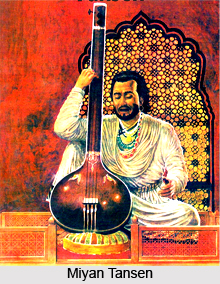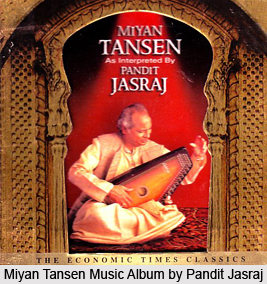 Tansen was the most renowned musician in the court of the Mughal emperor Akbar. He was born during the early part of the 16th century in a village called Behat, located about 7 miles from Gwalior. His father was a poet who belonged to the Gaudiya community. Tansen converted to Islam from Hinduism, supposedly, just before his marriage with Akbar`s daughter. It is believed that Tansen and his wife were childless for years and were blessed with a boy after they sought the blessings of a Sufi saint, Mohammed Ghouse. One story goes that the boy was converted to Islam by choice after he was blessed by Peer Mohammed Ghouse. However, the name by which he is known today, Mia Tansen, was conferred as an honour on him by Maharaja Ram Niranjan Singh of Gwalior.
Tansen was the most renowned musician in the court of the Mughal emperor Akbar. He was born during the early part of the 16th century in a village called Behat, located about 7 miles from Gwalior. His father was a poet who belonged to the Gaudiya community. Tansen converted to Islam from Hinduism, supposedly, just before his marriage with Akbar`s daughter. It is believed that Tansen and his wife were childless for years and were blessed with a boy after they sought the blessings of a Sufi saint, Mohammed Ghouse. One story goes that the boy was converted to Islam by choice after he was blessed by Peer Mohammed Ghouse. However, the name by which he is known today, Mia Tansen, was conferred as an honour on him by Maharaja Ram Niranjan Singh of Gwalior.
Early Life of Tansen
Tansen was educated in music by the well-known Dhrupad Singer Svami Haridasa. Svami Haridasa recognising Tansen`s innate gifts trained him rigorously in the art and science of Dhrupad. Tanna, it is said, was trained in the Gauhar (or Gaud) Bani. There are conflicting versions of this story. Some versions say that he served as a singer in the court of Man Singh Tomar for a while after spending a short time at Behat. Another school of thought believes that Tansen received his initial training in Dhrupad at the court of Man Singh Tomar, after which he moved to Vrindavan to study under Svami Haridasa. In any event, the years with the latter proved to be the most momentous in his early life.
Career of Tansen
Tansen served as a singer in the court of Maharaja Ram Niranjan Singh of Gwalior and then moved on to the court of Raja Ram Singh of Rewa. His prowess as a singer soon reached the ears of Emperor Akbar who requested Ram Singh, through his emissaries, to despatch Tansen to the imperial Darbar. Left with no choice, the king obeyed the royal diktat reluctantly and with much sorrow. In the court of Akbar, the name of Tansen was kept on the top. Tansen was soon to become the Emperor`s favourite and was elevated as one of the Navratna, Nine Gems, in the regal court. At Fatehpur Sikri, there is a seat, exclusively made for the court favourite, located at the centre of a once-beautiful pond next to the Emperor`s chambers. It is also reputed that there existed a deep bond between the Emperor and the singer.
 It was in the court of Akbar that Tansen created some of the greatest Raagas in Hindustani Music, like Mian ki Todi, Mian ki Sarang, Mian Malhar and Darbari Kanada. Whether Tansen really created them or whether he modified the existing versions of Todi, Sarang, Malhar and Kanada is open to debate. However, numerous Ragas have been created since then, but none possess the inimitable magic so characteristic of these Ragas, especially when they are sung by Dhrupad singers or performed by Beenkars of high calibre. Tansen wrote and sang a number of compositions glorifying his patron, as was the order of the day.
It was in the court of Akbar that Tansen created some of the greatest Raagas in Hindustani Music, like Mian ki Todi, Mian ki Sarang, Mian Malhar and Darbari Kanada. Whether Tansen really created them or whether he modified the existing versions of Todi, Sarang, Malhar and Kanada is open to debate. However, numerous Ragas have been created since then, but none possess the inimitable magic so characteristic of these Ragas, especially when they are sung by Dhrupad singers or performed by Beenkars of high calibre. Tansen wrote and sang a number of compositions glorifying his patron, as was the order of the day.
Personal Life of Tansen
Tansen taught music to all his children, including his daughter, Saraswati. Dhrupad Gharanas, especially the Rudra Veena players, of various hues and shades trace their origins back to the lineage of Tansen. To his daughter, he taught the art of transposing Dhrupad music onto the Rudra Veena. Soon the two were performing Jugalbandis together. To his sons, Bilas Khan, Surat Sen, Sarat Sen and Tarang Sen, he taught other stringed instruments like the Rebab. The Senia Beenkar Gharana of later years, initiated by Amrit Sen and his brothers in the court of Jaipur, traces its lineage to one or the other of Tansen`s children. The Senia Gharana, while largely confined to the Sitar, Sarod and Surbahar, remains to this day a mode of rendition. Many Dhrupad singers trace their origin to Tansen`s sons.
Death of Tansen
According to experts, Tansen died in the year 1586 in Delhi; and Akbar and his court had attended the funeral procession. Another version states that Tansen died on 1589. Tansen was buried in Gwalior, in the mausoleum complex of his guru Muhammad Ghaus.
Tansen contributed much to the development of Indian Classical Music. He systematised the chaotic jumble of Hindustani music from the point of view of a judicious performer. He excised the redundant and retained the vital. It was during his time that Dhrupad attained its fullest maturity. It was he who did much to perfect and popularize this form. Tansen left behind numerous couplets and pointers illustrating various subtle aspects of music. Some of these may have been composed by the master himself, the rest may be attributions.
Tansen penned a number of Naadopasana or Naad Mahima compositions which are sung by several Dhrupad singers and some Khayal singers even today.




















